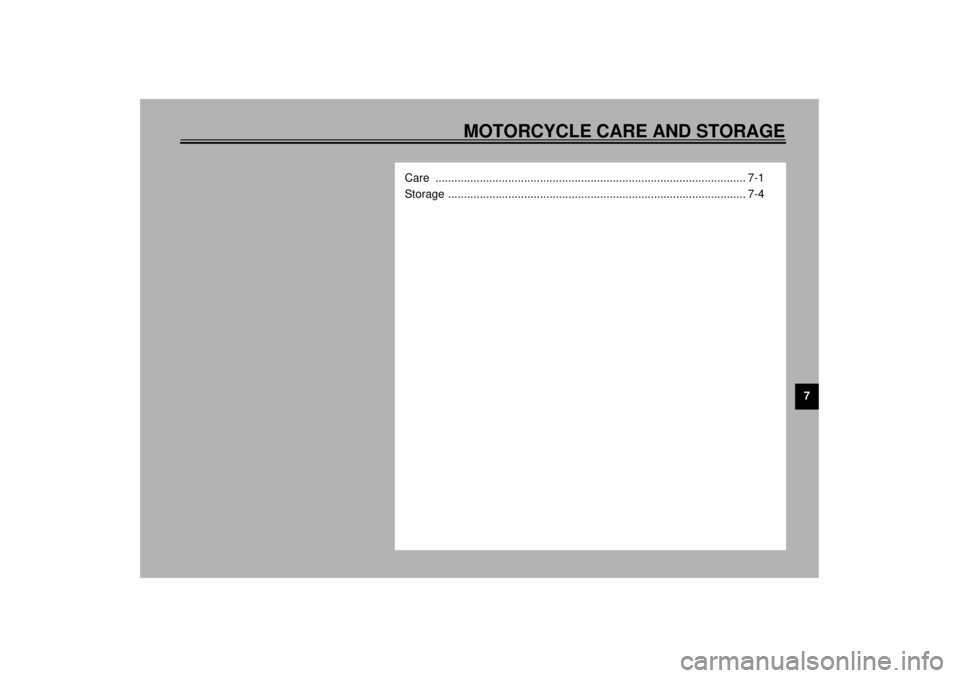Page 89 of 114
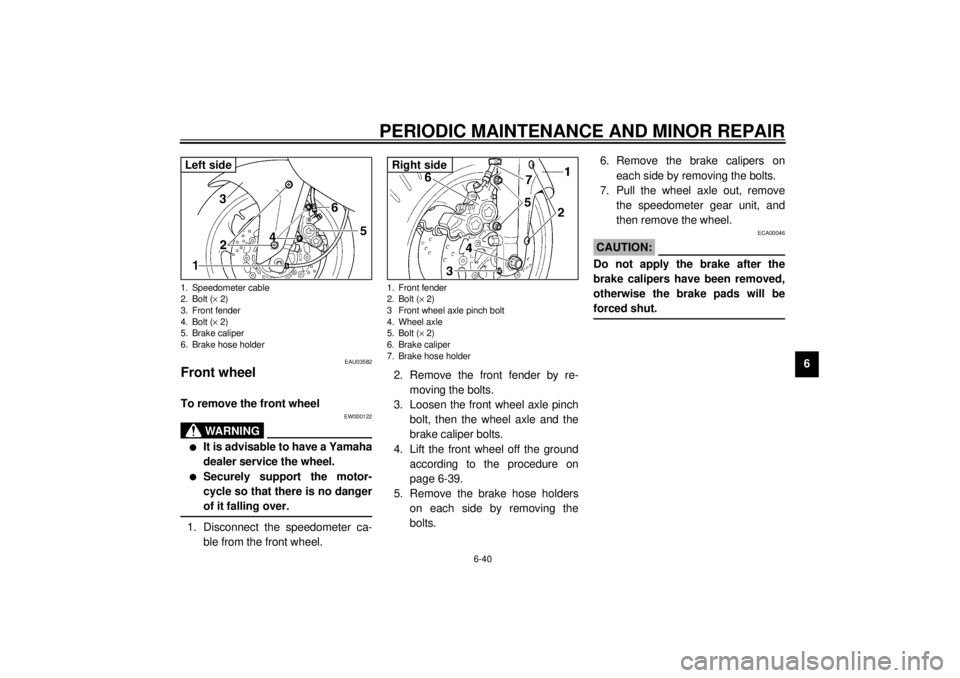
PERIODIC MAINTENANCE AND MINOR REPAIR
6-40
6
EAU03582
Front wheel To remove the front wheel
EW000122
WARNING
_ l
It is advisable to have a Yamaha
dealer service the wheel.
l
Securely support the motor-
cycle so that there is no danger
of it falling over.
_1. Disconnect the speedometer ca-
ble from the front wheel.2. Remove the front fender by re-
moving the bolts.
3. Loosen the front wheel axle pinch
bolt, then the wheel axle and the
brake caliper bolts.
4. Lift the front wheel off the ground
according to the procedure on
page 6-39.
5. Remove the brake hose holders
on each side by removing the
bolts.6. Remove the brake calipers on
each side by removing the bolts.
7. Pull the wheel axle out, remove
the speedometer gear unit, and
then remove the wheel.
ECA00046
CAUTION:_ Do not apply the brake after the
brake calipers have been removed,
otherwise the brake pads will be
forced shut. _
1. Speedometer cable
2. Bolt (´ 2)
3. Front fender
4. Bolt (´ 2)
5. Brake caliper
6. Brake hose holderLeft side
1. Front fender
2. Bolt (´ 2)
3 Front wheel axle pinch bolt
4. Wheel axle
5. Bolt (´ 2)
6. Brake caliper
7. Brake hose holderRight side
E_4tv.book Page 40 Wednesday, October 4, 2000 2:15 PM
Page 90 of 114
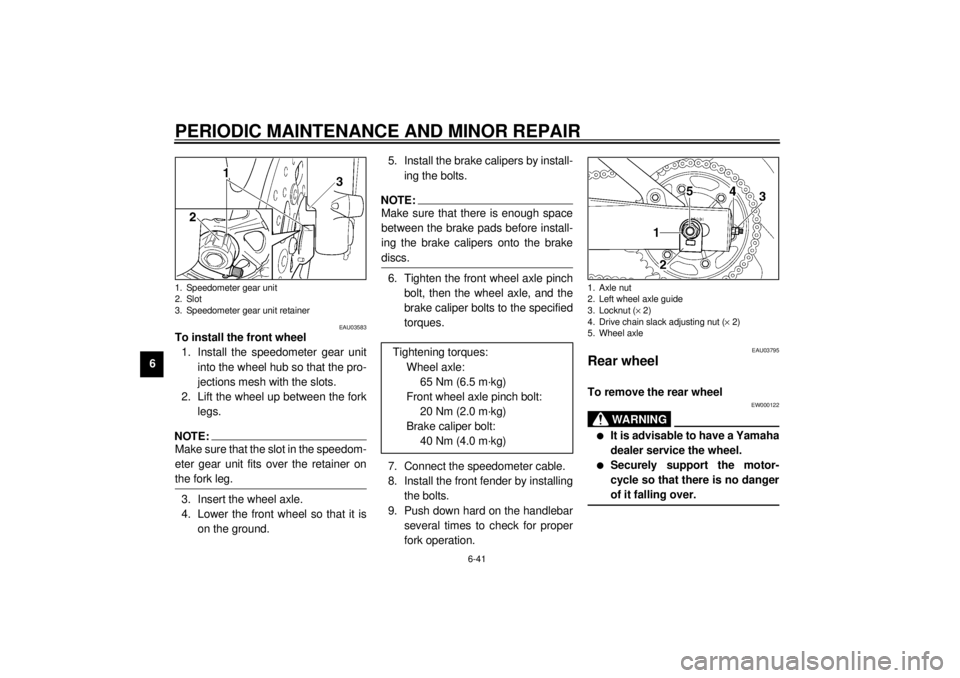
PERIODIC MAINTENANCE AND MINOR REPAIR
6-41
6
EAU03583
To install the front wheel
1. Install the speedometer gear unit
into the wheel hub so that the pro-
jections mesh with the slots.
2. Lift the wheel up between the fork
legs.NOTE:_ Make sure that the slot in the speedom-
eter gear unit fits over the retainer on
the fork leg. _3. Insert the wheel axle.
4. Lower the front wheel so that it is
on the ground.5. Install the brake calipers by install-
ing the bolts.
NOTE:_ Make sure that there is enough space
between the brake pads before install-
ing the brake calipers onto the brake
discs. _6. Tighten the front wheel axle pinch
bolt, then the wheel axle, and the
brake caliper bolts to the specified
torques.
7. Connect the speedometer cable.
8. Install the front fender by installing
the bolts.
9. Push down hard on the handlebar
several times to check for proper
fork operation.
EAU03795
Rear wheel To remove the rear wheel
EW000122
WARNING
_ l
It is advisable to have a Yamaha
dealer service the wheel.
l
Securely support the motor-
cycle so that there is no danger
of it falling over.
_
1. Speedometer gear unit
2. Slot
3. Speedometer gear unit retainer
Tightening torques:
Wheel axle:
65 Nm (6.5 m·kg)
Front wheel axle pinch bolt:
20 Nm (2.0 m·kg)
Brake caliper bolt:
40 Nm (4.0 m·kg)
1. Axle nut
2. Left wheel axle guide
3. Locknut (´ 2)
4. Drive chain slack adjusting nut (´ 2)
5. Wheel axle
E_4tv.book Page 41 Wednesday, October 4, 2000 2:15 PM
Page 91 of 114
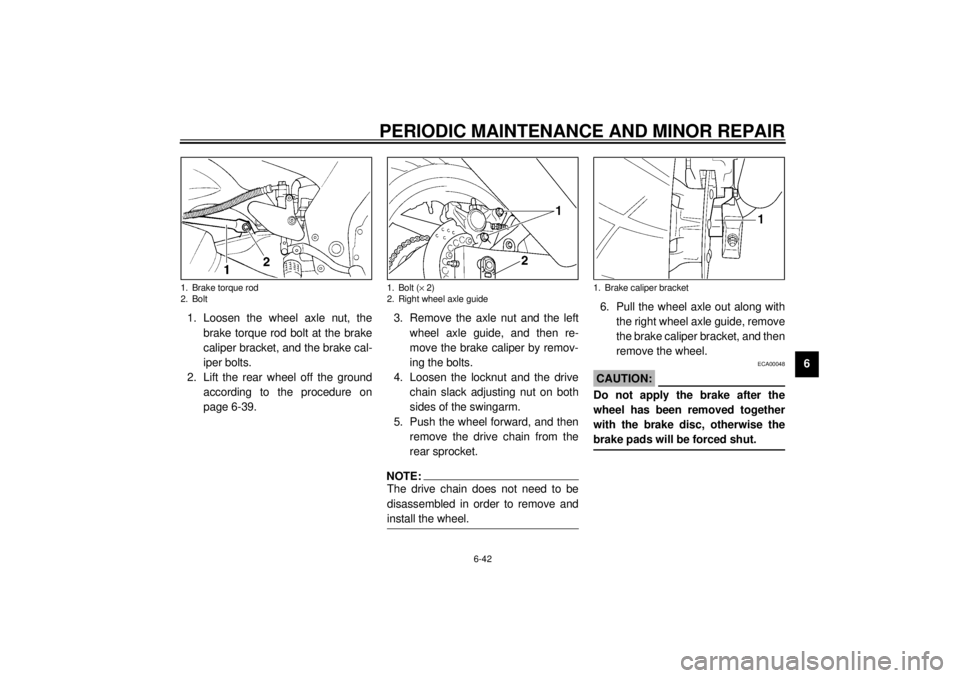
PERIODIC MAINTENANCE AND MINOR REPAIR
6-42
6 1. Loosen the wheel axle nut, the
brake torque rod bolt at the brake
caliper bracket, and the brake cal-
iper bolts.
2. Lift the rear wheel off the ground
according to the procedure on
page 6-39.3. Remove the axle nut and the left
wheel axle guide, and then re-
move the brake caliper by remov-
ing the bolts.
4. Loosen the locknut and the drive
chain slack adjusting nut on both
sides of the swingarm.
5. Push the wheel forward, and then
remove the drive chain from the
rear sprocket.
NOTE:_ The drive chain does not need to be
disassembled in order to remove and
install the wheel. _
6. Pull the wheel axle out along with
the right wheel axle guide, remove
the brake caliper bracket, and then
remove the wheel.
ECA00048
CAUTION:_ Do not apply the brake after the
wheel has been removed together
with the brake disc, otherwise the
brake pads will be forced shut. _
1. Brake torque rod
2. Bolt
1. Bolt (´ 2)
2. Right wheel axle guide
1. Brake caliper bracket
E_4tv.book Page 42 Wednesday, October 4, 2000 2:15 PM
Page 92 of 114

PERIODIC MAINTENANCE AND MINOR REPAIR
6-43
6
EAU03584
To install the rear wheel
1. Install the wheel, right wheel axle
guide, and caliper bracket by in-
serting the wheel axle from the
right-hand side.
2. Install the drive chain onto the rear
sprocket, and then adjust the drive
chain slack. (See page 6-29 for
drive chain slack adjustment pro-
cedures.)
3. Install the brake caliper by install-
ing the bolts.
NOTE:_ Make sure that there is enough space
between the brake pads before install-
ing the brake caliper onto the brake
disc. _4. Install the left wheel axle guide
and the axle nut, and then lower
the rear wheel so that it is on the
ground.
5. Tighten the axle nut, the brake cal-
iper bolts and the brake torque rod
bolt to the specified torques.
EAU03087
Troubleshooting Although Yamaha motorcycles receive
a thorough inspection before shipment
from the factory, trouble may occur dur-
ing operation. Any problem in the fuel,
compression, or ignition systems, for
example, can cause poor starting and
loss of power.
The following troubleshooting charts
represent quick and easy procedures
for checking these vital systems your-
self. However, should your motorcycle
require any repair, take it to a Yamaha
dealer, whose skilled technicians have
the necessary tools, experience, and
know-how to service the motorcycle
properly.
Use only genuine Yamaha replace-
ment parts. Imitation parts may look
like Yamaha parts, but they are often
inferior, have a shorter service life and
can lead to expensive repair bills.
Tightening torques:
Axle nut:
117 Nm (11.7 m·kg)
Brake caliper bolt:
40 Nm (4.0 m·kg)
Brake torque rod bolt:
30 Nm (3.0 m·kg)
E_4tv.book Page 43 Wednesday, October 4, 2000 2:15 PM
Page 93 of 114

PERIODIC MAINTENANCE AND MINOR REPAIR
6-44
6
EAU02990
Troubleshooting charts Starting problems or poor engine performance
EW000125
WARNING
_ Keep away open flames and do not smoke while checking or working on the fuel system. _
Check the fuel level in
the fuel tank.1. Fuel
There is enough fuel.
There is no fuel.
Check the compression.
Supply fuel.
The engine does not start.
Check the compression.
Operate the electric starter.2. Compression
There is compression.
There is no compression.
Check the ignition.
Have a Yamaha dealer
check the vehicle.
Remove the spark plugs
and check the electrodes.3. Ignition
Wipe off with a dry cloth and correct the
spark plug gaps, or replace the spark plugs.
Have a Yamaha dealer check the vehicle.
The engine does not start.
Have a Yamaha dealer
check the vehicle.
Operate the electric starter.4. Battery
The engine turns over
quickly.
The engine turns over
slowly.DryWet
The engine does not start.
Check the battery.Open the throttle halfway and operate
the electric starter.
The battery is good.Check the battery lead connections,
and charge the battery if necessary.
E_4tv.book Page 44 Wednesday, October 4, 2000 2:15 PM
Page 94 of 114

PERIODIC MAINTENANCE AND MINOR REPAIR
6-45
6Engine overheating
EW000070
WARNING
_ l
Do not remove the radiator cap when the engine and radiator are hot. Scalding hot fluid and steam may be
blown out under pressure, which could cause serious injury. Be sure to wait until the engine has cooled.
l
After removing the radiator cap retaining bolt, place a thick rag, like a towel, over the radiator cap, and then
slowly rotate the cap counterclockwise to the detent to allow any residual pressure to escape. When the hiss-
ing sound has stopped, press down on the cap while turning it counterclockwise, and then remove the cap.
_NOTE:_ If coolant is not available, tap water can be temporarily used instead, provided that it is changed to the recommended coolant
as soon as possible. _
Wait until the
engine has cooled.
Check the coolant level in the
reservoir and radiator.
The coolant level
is OK.The coolant level is low.
Check the cooling system
for leakage.
Have a Yamaha dealer checkand repair the cooling system.Add coolant. (See NOTE.)
Start the engine. If the engine overheats again,
have a
Yamaha dealer check
and repair the cooling system.
There is
leakage.
There is
no leakage.
E_4tv.book Page 45 Wednesday, October 4, 2000 2:15 PM
Page 95 of 114
MOTORCYCLE CARE AND STORAGE
7
Care .................................................................................................. 7-1
Storage .............................................................................................. 7-4
E_4tv.book Page 1 Wednesday, October 4, 2000 2:15 PM
Page 96 of 114

7-1
7
EAU03426
7-MOTORCYCLE CARE AND STORAGECare While the open design of a motorcycle
reveals the attractiveness of the tech-
nology, it also makes it more vulnera-
ble. Rust and corrosion can develop
even if high-quality components are
used. A rusty exhaust pipe may go un-
noticed on a car, however, it detracts
from the overall appearance of a
motorcycle. Frequent and proper care
does not only comply with the terms of
the warranty, but it will also keep your
motorcycle looking good, extend its life
and optimize its performance.Before cleaning
1. Cover the muffler outlet with a
plastic bag after the engine has
cooled down.
2. Make sure that all caps and covers
as well as all electrical couplers
and connectors, including the
spark plug caps, are tightly in-
stalled.
3. Remove extremely stubborn dirt,
like oil burnt onto the crankcase,
with a degreasing agent and a
brush, but never apply such prod-
ucts onto seals, gaskets, sprock-
ets, the drive chain and wheel
axles. Always rinse the dirt and
degreaser off with water.Cleaning
ECA00010
CAUTION:_ l
Avoid using strong acidic wheel
cleaners, especially on spoked
wheels. If such products are
used on hard-to-remove dirt, do
not leave the cleaner on the af-
fected area any longer than in-
structed. Also, thoroughly rinse
the area off with water, immedi-
ately dry it, and then apply a
corrosion protection spray.
l
Improper cleaning can damage
windshields, cowlings, panels
and other plastic parts. Use
only a soft, clean cloth or
sponge with mild detergent and
water to clean plastic.
E_4tv.book Page 1 Wednesday, October 4, 2000 2:15 PM
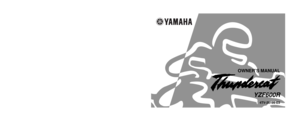 1
1 2
2 3
3 4
4 5
5 6
6 7
7 8
8 9
9 10
10 11
11 12
12 13
13 14
14 15
15 16
16 17
17 18
18 19
19 20
20 21
21 22
22 23
23 24
24 25
25 26
26 27
27 28
28 29
29 30
30 31
31 32
32 33
33 34
34 35
35 36
36 37
37 38
38 39
39 40
40 41
41 42
42 43
43 44
44 45
45 46
46 47
47 48
48 49
49 50
50 51
51 52
52 53
53 54
54 55
55 56
56 57
57 58
58 59
59 60
60 61
61 62
62 63
63 64
64 65
65 66
66 67
67 68
68 69
69 70
70 71
71 72
72 73
73 74
74 75
75 76
76 77
77 78
78 79
79 80
80 81
81 82
82 83
83 84
84 85
85 86
86 87
87 88
88 89
89 90
90 91
91 92
92 93
93 94
94 95
95 96
96 97
97 98
98 99
99 100
100 101
101 102
102 103
103 104
104 105
105 106
106 107
107 108
108 109
109 110
110 111
111 112
112 113
113





